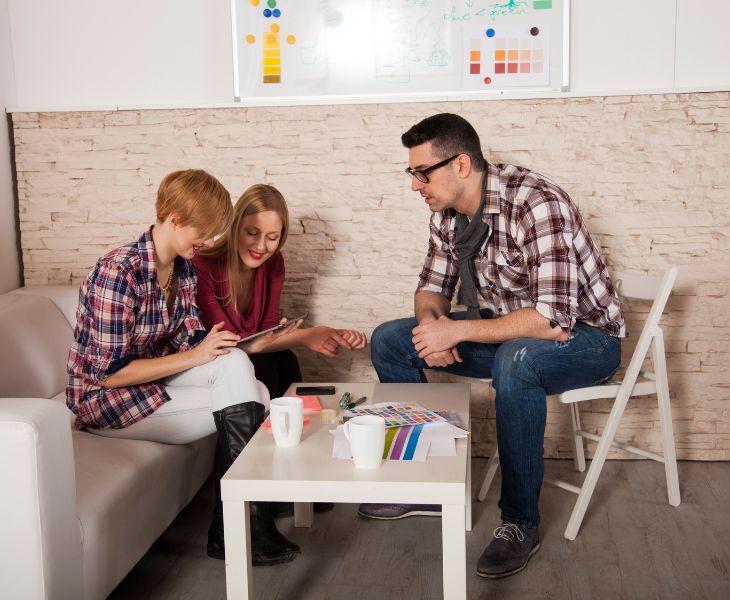Employees spend roughly one-third of their time at work, so if the workplace is dull, uncomfortable, and uninspiring, it obviously can have a negative impact on productivity and mood. Numerous studies have shown that office workspace design can impact how work gets done. Oxford University’s Saïd Business School research indicates that employees are 13 percent more productive and determined to achieve their goals when they are happy in the workplace. Promoting a happy and motivated work culture reduces work-related conflicts, lowers absenteeism and staff turnover rates, plus boosts morale and productivity.
But how is this happiness achieved? Aside from the obvious financial remuneration, some companies provide free snacks, top-top-of-the-line coffee machines, arcade games, and hybrid work arrangements, but there is one area that is more subtle and sometimes gets less credit for creating an inspiring atmosphere. Numerous studies have shown that office design — something many of us take for granted — can impact how work gets done, encouraging productivity, collaboration, and well-being.
Designing a workspace to boost productivity requires careful consideration of several factors, from how many employees there are and what their working preferences constitute, down to aspects such as where natural light
can be utilised. The goal of most office layout plans is to promote collaboration and fluid communication between employees, while retaining comfort and some spaces for reflection and concentration. The right balance of these
elements is crucial for productivity, better mental health, and improved morale
Mix up it up with Diverse Spaces
Open-plan layouts have evolved as a preferred office design choice; however, this design has also been associated with lower employee satisfaction and higher stress levels. A growing trend is to mix up open-plan designs with other spaces that foster better concentration and at times, privacy. Going beyond the one-size-fits-all approach and implementing
customised spaces to suit personal preferences is a way to empower employees, showing that you respect their preferred working environments.
Consider Break Areas
Well-designed break areas can provide a comforting setting to chat with colleagues or enjoy some quiet time away from the desk. These areas should be well-lit and may include different types of seating, such as comfy bean bags, sofas, and lounge chairs. For a change of scenery and fresh air, think about maximising any outdoor space available, installing suitable outdoor furniture.
Make Space for Collaboration
There’s a growing preference for shifting from desk areas to converge in communal areas set aside for brainstorming sessions or informal meetings; spaces that seek to encourage collaboration, communication, and creativity among staff. Collaborative furniture – such as modular seating systems and adjustable-height tables – are typically designed to be versatile and easily reconfigured suiting different groups and activities. Creating a more flexible and adaptable workspace helps foster a more productive work environment.
Think About Colour Psychology
Colour has a major effect on mood, emotions and productivity levels. Most office walls are painted white, but when it comes to employee effectiveness, studies indicate white is one of the worst colours to use: the sterile quality isn’t conducive to productivity and can lead to reduced stimulation. Similarly, grey should be used in small measures, as it lacks energy and suppresses emotions.
Conversely, avoid overly bright or distracting colours. The least favourite workplace colour, yellow, energises employees but can cause anxiety and isn’t recommended for conference rooms. Red is good for detail orientation, but it can also sabotage analytical thinking. The most preferable colours for the workplace are blue, which is calming and promotes communication, inspiring creative types, and green, which promotes harmony and balance, sparking creativity and innovation.
Improved Lighting
This is one of the easiest ways to boost productivity. Poor lighting can cause eye strain, headaches, fatigue, stress, and other physical and mental problems, hampering the ability to work efficiently. Try rearranging the floor plan to maximise natural light: install glass panels or skylights and if possible, consider shifting employees closer to the windows. Alternatively, install indirect artificial lighting, which can mimic natural light.
Opt for Ergonomic Set ups
Ensuring the workspace is ergonomically designed not only promotes good posture and reduces physical strain and fatigue from sitting all day, but also allows staff to work in the most comfortable and efficient way possible.
A COS 2022 study revealed that 68 percent of Australian office workers desired a more ergonomic setup, including ergonomic furniture such as sit-stand desks, desk chairs with adjustable lumbar support, and other supportive tools like footrests.
Add Greenery
Plants are well-known to improve mood, boost productivity, reduce stress levels, help promote better air quality, and create a sense of well-being and calm – making a welcome and aesthetically-pleasing addition to the office. You can further greenify the office by adding standalone, makeshift green walls; these work similarly to regular dividers but offer a more ecological and fluid touch.

